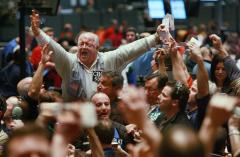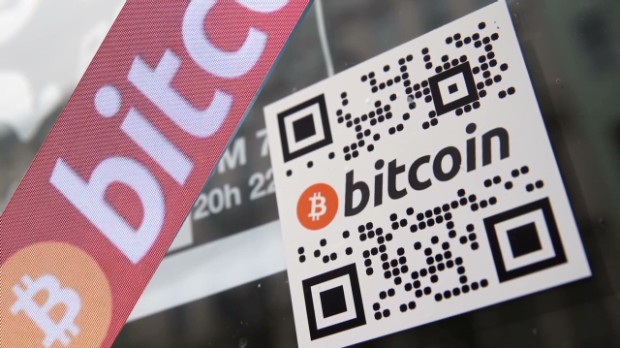 Related BABA Jack Ma: SEC 'Misunderstood' Alibaba's IPO Alibaba Shares Break $100 On Apple Partnership Rumors Amazon Earnings: What to Expect (Fox Business)
Related BABA Jack Ma: SEC 'Misunderstood' Alibaba's IPO Alibaba Shares Break $100 On Apple Partnership Rumors Amazon Earnings: What to Expect (Fox Business) U.S. stocks continued to charge forward as the Dow closed above the 17,000 mark as consumer confidence rose more than expected in October.
The Federal Reserve gathered Tuesday and will release a statement on Wednesday at 2:00 p.m. ET. It is not a foregone conclusion that the Federal Reserve will announce at that time the end its tapering activities.
The CBOE Volatility Index fell 8 percent to 14.76 as corporate earnings remain generally strong and Ebola related concerns appear to be dissipating, but still remain a closely watched topic.
Recommended: How Safe Are Low-Beta Stocks?
The Dow gained 1.12 percent, closing at 17,005.75. The S&P 500 gained 1.19 percent, closing at 1,985.05. The Nasdaq gained 1.75 percent, closing at 4,564.29. Gold lost 0.09 percent, trading at $1,228.20 an ounce. Oil gained 0.49 percent, trading at $81.40 a barrel. Silver gained 0.23 percent, trading at $17.20 an ounce. News Of NoteICSC Retail Store Sales rose 2.8 percent year over year after rising 2.1 percent last week.
September Durable Goods fell 1.3 percent (versus expectations of a 0.5 percent gain) to $241.6 billion.
August S&P Case-Shiller Home Price Index rose 0.2 percent month over month (versus expectations of 0.5 percent) after rising 0.6 percent in July.
Redbook Chain Store Sales rose 4.4 percent year over year after rising 4.1 percent last week.
October Richmond Fed Manufacturing Survey rose to +20 (versus expectations of +10) from +14 in September.
October Consumer Confidence rose to 94.5 (versus expectations of 87.0) from 89.0 in September.
Analyst Upgrades And Downgrades Of NoteAnalysts at Baird upgraded Buffalo Wild Wings (NASDAQ: BWLD) to Outperform from Neutral with a price target raised to $180 from a previous $160. Shares gained 13.35 percent, closing at $151.68.
Analysts at Wedbush initiated coverage of GoPro (NASDAQ: GPRO) with an Outperform rating and $81 price target. Shares gained 6.76 percent, closing at $69.30.
Analysts at JPMorgan maintained a Neutral rating on Kohl's (NYSE: KSS) with a price target lowered to $50 from a previous $55. Shares lost 6.64 percent, closing at $54.66.
Analysts at Baird downgraded Sarepta Therapeutics (NASDAQ: SRPT) to Neutral form Outperform with a price target lowered to $21 from a previous $53. Shares lost 4.97 percent, closing at $15.12.
Recommended: Apple To Benefit As China's 3G Subscribers Break Through The Half-Billion Mark
Analysts at Citigroup maintained a Buy rating on Treehouse Foods (NYSE: THS) with a price target raised to $100 from a previous $93. Shares gained 3.12 percent, closing at $83.50.
Analysts at Wedbush maintained a Neutral rating on Twitter (NYSE: TWTR) with a price target lowered to $40 from a previous $50. Analysts at Pivotal Research upgraded to Hold from Sell with a price target raised to $42 from a previous $38. Analysts at Nomura downgraded to Neutral from Buy with a price target lowered to $45 from a previous $55. Analysts at Citigroup maintained a Neutral rating with a price target lowered to $47 from a previous $53. Analysts at Canaccord Genuity maintained a Buy rating with a price target lowered to $56 from a previous $62. Shares lost 9.84 percent, closing at $43.78.
Analysts at JPMorgan maintained a Neutral rating on Under Armour (NYSE: UA) with a price target lowered to $60 from a previous $63. Shares lost 0.63 percent, closing at $64.30.
Equities-Specific News Of NoteBlackstone (NYSE: BX) plans to raise $13 billion for a new global real estate fund. Shares gained 0.53 percent, closing at $30.55.
Alibaba's (NYSE: BABA) CEO Jack Ma said he is willing to cooperate with Apple (NASDAQ: AAPL) on a mobile payment system. Shares of Alibaba hit new 52-week highs of $100.67 before closing the day at $99.68, while shares of Apple gained 1.51 percent, closing at $106.70.
Novartis (NYSE: NVS) said that its experimental heart failure drug LCZ696 will eventually generate $2 billion to $5 billion in sales. Shares gained 2.37 percent, closing at $92.35.
Regal Entertainment Group (NYSE: RGC) disclosed that it is exploring a potential sale of itself. Shares gained 3.75 percent, closing at $21.28.
IBM (NYSE: IBM) said it will add $5 billion to its current share buyback plan, bringing the total authorization to $6.4 billion. Shares gained 1.07 percent, closing at $163.60.
InterDigital (NASDAQ: IDCC) won a Delaware infringement suit against ZTE.
Related: InterDigital Traders Selling On News After Buying On Rumors
Winners Of NoteTesla Motors' (NASDAQ: TSLA) CEO Elon Musk said that the company's September sales rose 65 percent year over year, contradicting reports from yesterday that indicated a slowdown in sales. Shares gained 9.45 percent, closing at $242.62, up 9.45 percent.
Madison Square Garden (NASDAQ: MSG) is considering splitting itself in to two companies; the first division will focus on sports and media, while the other will focus on real estate holdings. Shares hit new 52-week highs of $74.00 before closing the day at $73.00, up 10.98 percent.
Receptos (NASDAQ: RCPT) announced that its lead product candidate RPC1063 successfully achieved its primary endpoint in a Phase 2 clinical study, which evaluated safety and efficacy for the treatment of ulcerative colitis with a 1 mg dose. Shares surged to new 52-week highs of $102.60 before closing the day at $95.75, up 41.35 percent.
Decliners Of NoteSanofi (NYSE: SNY) said that sales of its diabetes products will be flat next year due to heightened competition in the U.S. Shares lost 8.99 percent, closing at $48.07.
NQ Mobile (NYSE: NQ) rejected Bison Capital's buyout offer of $9.80 per share but remains in active discussions with the firm over other opportunities for investments and collaboration. Shares lost 15.43 percent, closing at $8.00.
Earnings Of NoteE.I. du Pont (NYSE: DD) reported its third quarter results this morning. The company earned $0.54 per share, beating the consensus estimate of $0.53. Revenue of $7.51 billion missed the consensus estimate of 7.95 billion. Shares gained 0.10 percent, closing at $67.95.
Novartis (NYSE: NVS) reported its third quarter results this morning. The company earned $1.37 per share, beating the consensus estimate of $1.29. Revenue of $14.70 billion beat the consensus estimate of $14.34 billion. Shares gained 2.37 percent, closing at $92.35.
Recommended: Street Leaned The Right Way Ahead Of Twitter's Earnings
Pfizer (NYSE: PFE) reported its third quarter results this morning. The company earned $0.57 per share, beating the consensus estimate of $0.55. Revenue of $12.36 billion beat the consensus estimate of $12.23 billion. Shares gained 0.21 percent, closing at $29.09.
Coach (NYSE: COH) reported its first quarter results. The company earned $0.53 per share, beating the consensus estimate of $0.46. Revenue of $1.04 billion beat the consensus estimate of $1.01 billion. Shares hit new 52-week lows of $33.25 before closing the day at $34.00, down 5.95 percent.
Freeport-McMoRan (NYSE: FCX) reported its third quarter results this morning. The company earned $0.64 per share, beating the consensus estimate of $0.62. Revenue of $5.70 billion was in line with the consensus estimate. Shares hit new 52-week lows of $28.64 before closing the day at $29.03, down 4.16 percent.
Facebook (NASDAQ: FB) reported its third quarter results after market close. The company earned $0.43 per share, beating the consensus estimate of $0.40. Revenue of $3.20 billion beat the consensus estimate of $3.11 billion. Shares were trading lower by 0.53 percent at $80.34 following the earnings release.
Quote Of The Day“That's a range that the service industry and our customers can easily live within." - Halliburton CEO David Lesar on how the market will react to crude prices between $80 to $100 per barrel.
Posted-In: AerohiveEarnings News Econ #s Economics After-Hours Center Markets Movers Best of Benzinga
© 2014 Benzinga.com. Benzinga does not provide investment advice. All rights reserved.
Related Articles (AAPL + BABA) Markets Continue To Rally As The Dow Closes Above 17,000 Jack Ma: SEC 'Misunderstood' Alibaba's IPO Apple, Aerohive Join Forces In ConnectED Wells Fargo Digs In To Apple's 10-K: iPhone 6 Gross Margins May Be Below iPhone 5 Apple To Benefit As China's 3G Subscribers Break Through The Half-Billion Mark Alibaba Shares Break $100 On Apple Partnership Rumors Around the Web, We're Loving...
 5 bad signs for Bitcoin
5 bad signs for Bitcoin 

 Reuters
Reuters  The Walt Disney Company
The Walt Disney Company  MSFT's Windows 10 Catch
MSFT's Windows 10 Catch